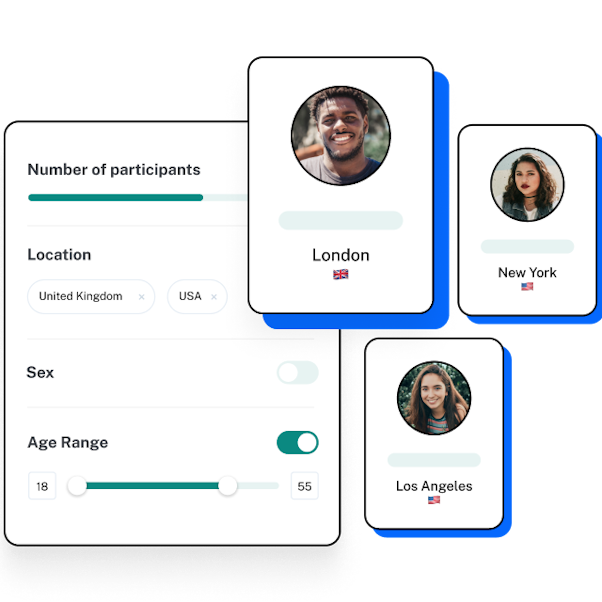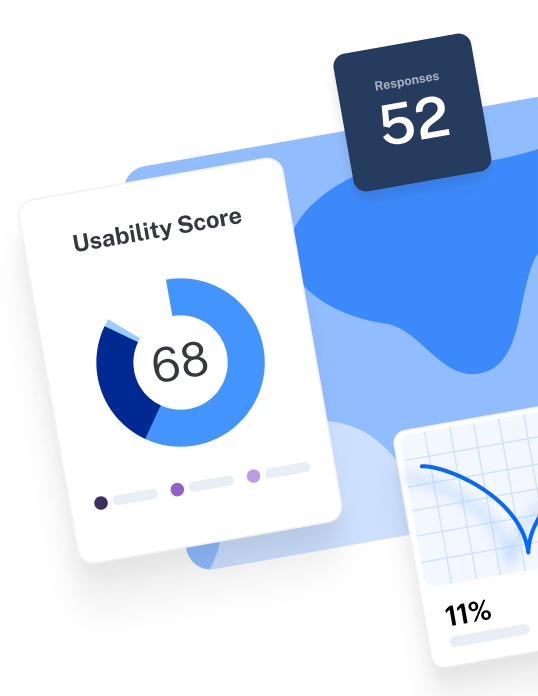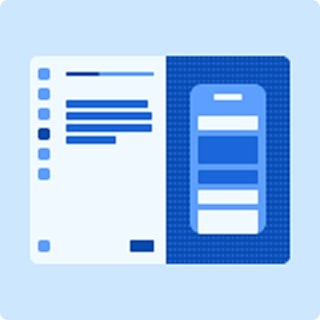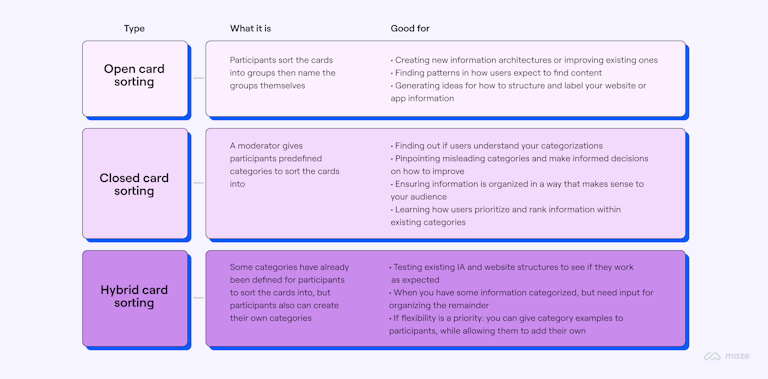Chapter 2
8 Content testing methods you need to know: Step-by-step for evaluating UX content
Content quality plays a central role in the success of your UX. Here’s our deep dive into content testing methods, plus five simple steps to conduct content testing right away.

Choosing the right content testing method helps you get data-backed user insights, optimize your content, and turn your target audience into long-term users.
In this chapter, we break down eight key content testing methods, before showing you how to conduct content testing in five simple steps.
What is content testing: A recap
Missed the first chapter on the ins and outs of content testing? No worries—if you’re keen to dive in, here’s a quick recap to get you up to speed.
Content testing is a research technique for assessing the quality and performance of product and UX content. Different content testing methods help assess:
- Usability
- Readability
- Accessibility
- Searchability
- Tone of voice
- Navigability
Ultimately, content testing ensures your content addresses your target audience’s pain points and gives them enough context to complete crucial tasks.
What are the types of content testing?
Like all UX research methods, content testing methods fall into different categories depending on how you’ll conduct your research. Your ideal type depends on your organization, resources, and needs.
Moderated vs. unmoderated content testing
Moderated content testing involves a researcher being present to guide the study and interact with the participant: moderated user testing is beneficial because it lets you read your participant's body language and gives you the opportunity to ask them follow-up questions. Some moderated content testing methods include task-based usability testing, card sorting, and five-second tests.
Unmoderated content testing does not require the presence of a moderator to guide the study, and users complete the task unaided: unmoderated content testing is beneficial because it minimizes the risk of cognitive bias, and allows you to test a large sample size without monitoring sessions. Unmoderated content testing examples include A/B testing and in some cases, cloze testing.
Remote vs in-person content testing
Remote testing lets you get feedback online with the help of a content testing tool. These allow you to design, deploy, and manage tests without physically being in the room with your participant. It’s easy, convenient, and lets you conduct testing without using up valuable resources.
In-person testing requires you to be in the same room as your participant and monitor the session. While you can still use specialized tools as aids, the focus should be on directly interacting with your participant. With in-person testing, you can watch participants complete the study in front of you.
8 Content testing methods for UX research
There are eight primary methods for testing content, with each being ideal for specific UX research objectives, available resources, or content focus.
1. Task-based usability testing: Best for evaluating content effectiveness
Task-based usability testing involves giving your participants a specific task to complete using your product to assess how easily they’re able to complete it. In a typical usability test example, users complete pre-scripted tasks that are closed-ended and shorter in form. However, when testing content, keep the tasks open-ended and allow users to explore the product in their own time.
Notice how users engage with a website or app, how they find the information they need, and whether they run into any confusion. The goal of usability testing is to assess if your content enables users to complete tasks successfully.
When conducting task-based usability tests make sure to keep a close eye on user behavior. Are they struggling throughout user flows? How can your content be improved to eliminate confusion?
Testing this way will provide you with qualitative information about what works and what doesn’t, and give you insight into which content may need to be changed or improved.
Always keep the behavior in mind: what users do during the test might contradict or confirm what the user says.
Vaida Pakulyte
UX Lead at Technigo
Share
Usability testing provides the perfect opportunity to make sure you and your users are on the same page in regards to the language used.
2. Cloze test: Best for measuring content comprehension
Cloze testing is a content testing method in which participants fill in missing words from a passage. This method helps you evaluate how understandable your content is. You can design a cloze test by taking a 125- to 250-word piece of text and removing one every few words, typically every fifth or sixth.
You present this text to a test participant and see how many of the missing words they can guess correctly. An overall score of 60% or above is deemed comprehensible enough to meet user needs.
Here’s a short example of what a Cloze test looks like:
When Mr. Bilbo Baggins _____ Bag End announced that _____ would shortly be celebrating _____ eleventy-first birthday with a _____ of special magnificence, there _____ much talk and excitement _____ Hobbiton.
3. Card sorting: Best for assessing content structure and categories
Card sorting enables you to learn how users understand and categorize information. It consists of having users group ideas or information in a way that makes sense to them using physical or virtual cards.
There are three different types of card sorting, all of which help at different stages of the content testing process. For example:
- Open card sorting: Helps generate ideas and define new information architecture, and should be used during the initial content development process
- Closed card sorting: Helps evaluate current information architecture and naming conventions, and should be used to test existing content
- Hybrid card sorting: Combines the above two card sorting processes, and should be used during the first iterations of your content development
For more information on card sorting and how it can help you better structure content, take a look at our guide to running a card sort
4. Highlight testing: Best for getting direct content feedback
A highlight test is particularly useful for pinpointing strengths and weaknesses in your content—whether that’s in terms of branding, customer confidence, comprehension, or any other aspect. It’s a versatile method that you can use to measure anything from comprehension to content effectiveness.
To do a highlight test, you’ll need a sample of your text and a red and green highlighter. Next, choose what aspect of your content you’d like to test, such as tone or clarity.
After giving participants your chosen text, ask them to highlight content that aligns with their expectations regarding the specific aspect you’re testing in green, and content that doesn’t in red.
5. Five-second testing: Best for measuring your content’s first impression
In a five-second test, you present your users with a design and give them five seconds to look at it, then ask them questions. This method can be used to test landing page copy, UI content, and more. You’re testing to see if the information on your page can be quickly absorbed, perceived, or understood.
The questions you ask can range from broad, like “What do you think of the page?” or “What do you remember seeing?” to more specific ones, like “Which of the items are on sale?”.
It’s best to start the test with broad questions to get general feedback and thoughts from your participants, then asking more specific questions to see what information stuck with them.
6. Preference testing: Best for testing content preferences early on
Preference testing consists of showing research participants two to three versions of your design—in this case, with variations in the content—to get an idea of which they prefer and why. It can help you understand the user’s perception of your content and lets you align with their preferences.
Testing content helps me understand the emotion my designs need to convey: more formal, informal, chill, educational, and so on.
Vaida Pakulyte
UX Lead at Technigo
Share
Preference testing is best used during your initial testing process to help you understand what works and what doesn’t before committing to a specific content or communication style. It’s similar to A/B testing—which we’re covering next—with the primary difference being when you should use it. Preference testing should be used on content drafts and wireframes, whereas A/B testing is better suited for live content.
7. A/B testing: best for comparing content
A/B testing involves creating two variations of content and testing them with users on live websites. A/B tests can give you quantitative data on which content performs better.
This type of testing can provide useful UX metrics, such as the click-through rate (CTR) that allow you to determine the winning variation easily. However, to do well, you need to have a large sample size for statistical significance.
For example, Netflix is well-known for A/B testing artwork for titles to identify which images perform best at getting users to watch videos.
8. Readability testing: Best for assessing your content’s clarity
Readability formulas are a computer-run UX testing tool that provides an analysis of your content. They’re a simple way of testing how easy your copy is to read by prioritizing small words and short sentences.
However, if you’re truly aiming to test your content with real users, then readability formulas might not be the best option. While they may be an attractive solution, especially if you’re on a budget, they can often produce inconsistent results, and they don’t give any actionable feedback.
For better results, use readability tests in combination with the other methods described above for a mix of quantitative and qualitative data from real users.
✨ Pro tip
Already settled on a method for content testing? Before diving into the five steps for content testing, consider these content testing templates for your visual elements, web pages, copy, and messaging.
How to test content in 5 steps
Now you know the methods available for content testing, let’s cover the steps to start evaluating your content.
1. Identify goals
Before you even start planning your test, you need to consider what your objective is. In short, who and what are you testing, and what are your goals?
You should know who your intended users are, and what their needs and expectations from your product are. If your product is used by people from a range of demographics, then the product should be tested with users from each group. If your test underrepresents a demographic, then you risk creating content that doesn’t speak to all your personas.
After choosing the content you want to test, create a concrete research hypothesis and you’re ready to start outlining the test.
2. Choose your method and create the test
After settling on your objective, you can choose the most suitable method and create your test.
How you design a test heavily impacts its result, so constantly questioning why and how you’re testing something is crucial.
Nicole Michaelis
Content Design Lead at Wolt
Share
For example:
- We want to test if our users can understand how to make in-app purchases. We will use a task-based usability test to see if they can successfully complete tasks with the app.
- We want to test if our homepage speaks to our target demographic. We will use a highlight test to gauge their feelings about it.
- We want to see how users perceive our product homepage at first glance. We will use a five-second test to measure this initial impression.
💡 Pro tip
In your test, don’t ask the users if they 'like' the content. Ask if they can navigate easily, if they understand a paragraph, or if the tone makes them feel comfortable. Be specific, and measurable: what matters is whether it’s relevant and comprehensible.
3. Test your method with colleagues
Before you start recruiting research participants, grab some colleagues or other stakeholders and conduct a pilot test. This helps you catch any issues with your test design before you release it to real users.
Test the test! A mistake I’ve made in the past is making the test and then launching it straight to users. It was then that I discovered issues in the test as I was running it.
Steve Howe
Content Designer
Share
By running your test with a small internal group, you can ensure your instructions are clear and the test flows as intended.
4. Gather test participants
You’ve successfully created your test and you’ve run through it with colleagues and stakeholders. Now it’s time to find the participants you’ll be testing with.
If you’re conducting qualitative sessions, you need to find at least five participants. If you want to collect quantitative data, then it’s best to run the test with at least twenty people or more for statistical significance. Ultimately, how many people you need for user testing depends on the type of test you’re doing, the method, and the criticality of the project.
We recommend testing with at least 7 to 10 users. After 7 users, you’ll start to see the majority of usability issues or content-related problems that need addressing.
Kate Varga
Senior UX/UI Designer at Creative Navy
Share
Kate also notes: "If you’re working with limited resources, it’s often more effective to test with a smaller, targeted group of users and focus on gathering in-depth insights. If the goal is to test a large variety of content or gather feedback from multiple regions or user types, you’ll need more participants to ensure the results are comprehensive and reflective of different use cases.”
When it comes to recruiting research participants, there’s many ways to get participants. You reach out to your customer base, use participant recruitment tools, or spread the word among your professional networks.
Jump-start recruitment with for content testing
Maze Panel is a participant recruitment tool that connects you with ready-to-go research participants all over the world

5. Conduct the test and analyze the results
Once you’ve found the participants you need, it’s time to conduct your test and collect feedback. Having a facilitator present (moderated testing) can provide an extra layer of feedback from the study. Moderating these studies allows you to ask follow-up questions specific to the user and the situation they find themselves in.
With unmoderated testing, you don’t need to find someone to act as a moderator for the test, so you can run them faster.
Once you’ve conducted your tests, you’re ready for user research analysis. At the end, you’ll have an overall summary of how your content performs, as well as specifics to improve on—be it readability, voice, or any other important factor.
Note that these tests shouldn’t be a one-off—as Nicole puts it: “testing is never complete”. As your product and user base grow and evolve, you need to keep testing to see if your content continues to work and speak to them.
Next up: Content testing tools
Choosing the right content testing method makes all the difference in getting data-backed, game-changing insights for your content.
While effective, content testing has a lot of moving parts to stay on top of. From recruiting participants to devising tests, it takes a considerable amount of time and effort.
That’s why you need a tool for the job.
In the next chapter of this guide, we take you through the top content testing tools, their main features, and price points.
See you there.
Start testing your content with Maze
From a suite of comprehensive user research tools to automatic analysis, Maze gives you everything you need to get came-changing insights.

Frequently asked questions about content testing methods
How do you test content?
How do you test content?
To test your content, begin by identifying your goals and choosing the right method. Some of the most common and effective methods include:
- Task-orientated usability testing
- Cloze tests
- Card sorting
- Highlight testing
- Five-second testing
Once you’ve chosen your method for content testing, continue by testing with your team before conducting the test with your participants and analyzing the results.
How many participants do you need for content testing?
How many participants do you need for content testing?
The number of participants you need for content testing depend on your chosen method and your test goals. Typically, five to eight users are enough for task-orientated usability content testing. Other methods like A/B content testing warrant a larger sample size of 30 to 100 participants for statistically significant results.



